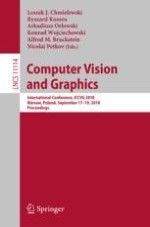2018 | Buch
Computer Vision and Graphics
International Conference, ICCVG 2018, Warsaw, Poland, September 17 - 19, 2018, Proceedings
herausgegeben von: Leszek J. Chmielewski, Ryszard Kozera, Arkadiusz Orłowski, Dr. Konrad Wojciechowski, Prof. Alfred M. Bruckstein, Nicolai Petkov
Verlag: Springer International Publishing
Buchreihe : Lecture Notes in Computer Science
